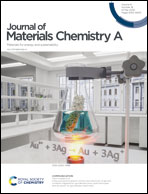Design of an alkaline pyridyl acceptor-based calix[4]arene dye and synthesis of stable calixarene–TiO2 porous hybrid materials for efficient photocatalysis†
Abstract
A porous organic–inorganic hybrid material consisting of calix[4]arene dye C4BTP with pyridine as an acceptor and titanium dioxide, denoted as C4BTP–TiO2, has been prepared by a facile sol–gel method. The C4BTP–TiO2 materials show expandable photocatalytic activities for H2 evolution from water and CO2 reduction to CO when they are loaded with Pt nanoparticles or rhenium complex ReCl(bpy) (CO)3 (ReP) as co-catalysts, respectively. The optimized Pt/C4BTP–TiO2 (5.0 wt%) catalyst exhibits a high H2 production activity (11.99 mmol g−1 h−1 based on catalyst mass) and excellent recyclable durability (a turnover number of 12 981 within 50 h after 10 rounds) under visible-light (λ > 420 nm), presenting one of the best performances among all the heterogeneous photocatalytic systems based on metal-free sensitizers. As a contrast, the surface sensitized catalyst Pt/gel-TiO2/C4BTP only shows far lower activities than hybrid Pt/C4BTP–TiO2 under the same conditions. In addition, the optimized ReP/C4BTP–TiO2 (5.0 wt%) catalyst obtained by loading ReP exhibits a selective photoactivity for CO2 reduction to CO, giving a turnover number of 112 after 25 h of visible-light irradiation. The good photoactivity and durability of the as-prepared hybrid materials can be attributed to the firm Ti–N linkage and efficient electron transfer between metal-free dye C4BTP and the substrate TiO2, while the alkaline-stable Ti–N bond improves the stability of the photocatalysts under basic aqueous conditions. This study offers a good example for the design and preparation of stable organic/inorganic hybrid materials applied in solar energy-solar fuel conversion.
![Graphical abstract: Design of an alkaline pyridyl acceptor-based calix[4]arene dye and synthesis of stable calixarene–TiO2 porous hybrid materials for efficient photocatalysis](/en/Image/Get?imageInfo.ImageType=GA&imageInfo.ImageIdentifier.ManuscriptID=D0TA00754D&imageInfo.ImageIdentifier.Year=2020)


 Please wait while we load your content...
Please wait while we load your content...